
THE STILLNESS OF THE LIVING FOREST:
A Year of Listening and Learning
John Harvey. Shanti Arts Publishing (www.shantiarts.com), 2018. PP. 238. $24.95 PAPER
Reviewed by Jan Cheripko
“I need to get away for awhile.” It’s a recurring and persistent internal refrain for many of us. John Harvey did just that. And his book, The Stillness of the Living Forest: A Year of Listening and Learning is not only an insightful look into his experience but, perhaps more importantly, it’s a call from the wild to the part in us longing to reconnect with something visceral and real; a promise that if we were to act on that soft suggestion all kinds of secrets would be revealed.
While the urges to shut down and withdraw come and go in most of us, it’s usually a crisis of some kind that actually prompts us to action. To paraphrase Plato, the creative experience requires the engagement of our emotions, intellect, and will. We have to feel it, think it, and do it. A crisis engages all three. For Harvey, a clinical psychologist, who spent most of his adult life in the rewarding yet challenging profession of trying to unravel tangles of discord in others, and then rebind newer, stronger, healthier threads, the crisis was retirement.
“[A] deep weariness, a kind of burn out pervaded my body and mind,” he writes. “…I needed regeneration…. My inner well of empathy had run dry.” So he turned to the world of nature for his renewal. His new life of retirement would begin by reconnecting with the sights, sounds, smells, and feelings offered in the ever-changing seasons enveloping Prompton Lake, a short, ten-minute drive from his home in northeast Pennsylvania.
Borrowing from Jon Young’s book, What the Robin Knows, Harvey sketched out a self-imposed proposal. “The plan was straightforward,” he tells us, “For fifty-two consecutive weeks I would go alone to the same spot in the
woods, sit still, engage my senses, and observe the flow of nature through the full four seasons.”
We all know that once such a sincere decision has set itself in our minds and hearts, obstacles arise. Even on the first day, Harvey found himself blocked—literally—from his journey into the woods.
Walking eagerly across the driveway, I glanced toward the street and noticed a contingent of tree trimmers cutting back branches from around the power lines. I turned, looked more closely, and to my dismay saw a huge pile of cut branches heaped across the end of the driveway next to a dump truck towing a wood chipper.
Harvey
asked the men to clear the site, and, begrudgingly,
they let him pass. Soon he was at the West Shore Trail of Prompton Lake, a
290-acre freshwater reserve created in 1960 by the Army Corps of Engineers as a
means of preventing yet another catastrophic flood of the Lackawaxen River from engulfing the downriver borough of Honesdale.
It was February 22, 2013. Harvey’s weekly journey into the wild was about to start.
After a few minutes of walking, I came to a seep, a thin sheet of water flowing downhill, spring water squeezing out from under an old stone wall, water warm enough to nourish a bright green wedge of cress and moss that traced downhill across the snow-covered ground, a patch of vibrant life amid a moribund winter landscape, a view so vibrant, so surprising, so awe-inspiring, that I paused to take it in.
What lay ahead was a week-after-week immersion into a world beyond the limiting confines of the seemingly important demands enclosed in a well-structured daily itinerary. As Harvey points out, we’re front-lobed people who think “top down,” that is, we rely primarily on our rational minds to solve a host of familial, social, economic, and political problems. The realm he now entered required a “bottom-up” approach—an opening of his emotions, stripped as much as possible of unrelenting petitions to explain, answer, decipher, analyze, and unscramble.
The process would be simple. Find a “sit spot.” Stay there in silence for an hour. At ten minute intervals, write notes on what he saw, heard, felt, smelled, even tasted.
Of his very first attempt, he writes, “During the fourth ten minutes my whole experience shifted, as my senses seemed to open up. Directly in front of me I saw a long maroon blackberry cane arcing gracefully over the white snow. How did I miss it?”
Returning to the comfortable warmth of his car, Harvey was jerked back into the rational world: “The chiming phone with its demands for action felt like a summons back to my old life, a demand to use my mind in all the familiar worn out ways.”
But something had already shifted in him: “…the view of the vast open, snow white lake merging into a forest of uncountable trees looked like an invitation to a new life, a life with new ways of sensing, feeling, experiencing, learning, and knowing.”
Throughout the year, the “new life” would offer him countless opportunities to know the “bottom up” way of experiencing the world. He learned to trust his intuition, which, on one occasion, prompted him to move his “sit spot.” Moments later a large black bear ambled through the spot where he had just been.
Sometimes, when he was traveling, Harvey found a sit spot in the wild at hand. A park in Germany while visiting his daughter from a previous marriage provided the right place for deep reflection of his relationship with his first wife.
…I felt regret for all the silly and inconsequential, lingering, post-divorce arguments and hostilities…. grateful that among the crazy circumstances of our time together in the stressful context of an American-German marriage, we created such a wonderful daughter.
While in Colorado, Harvey’s search for a sit spot led him astray, and he found himself sliding down a brambleberry-infested ravine, and then walking past a sign that stated emphatically: “PRIVATE PROPERTY. NO TRESPASSING. VIOLATORS WILL BE SHOT FIRST AND QUESTIONED LATER.”
But it was at Prompton Lake surrounded by the comforting sights and sounds of the creatures of the air that he felt most at home, and it was they who provoked his deepest thoughts.
I listened to the individual voices of the jays—some high some low. I heard the similarly unique caws of each crow. I listened to the song sparrow, knowing that in Ohio or Oregon its song would be slightly different, sung in a local accent. I heard two cardinals each with a slightly different song, each seemingly tweaking, changing, and improving its offering.
Variation, variation, and more variation…. What was this drive to diversity? Was it an evolutionary principle to keep spinning off new songs and novel behaviors to seize a selective advantage? … Was there some resonance between this diversity in song and plumage and the idea of an infinitely expanding universe?
Sometimes what the birds presented was unexpectedly sublime, as in this courtship of two cedar waxwings:
I spotted two more waxwings perched on a Russian olive branch, a male and female, next to each other. The male plucked a green berry, held it in his bill, and offered it to the female. She took it, held it briefly in her beak, and then returned it. He offered it again. She accepted and this time lifted her head and swallowed the berry. They hopped in tandem along the branch and then flew off wing to wing.
Harvey was fitting in. Midway through his fifty-two-week commitment, Harvey recalled the ideas of Carl Jung: “[H]e (Jung) explained that the ancient texts did not ask, ‘What causes what’? Rather, ‘What likes to occur with what’?
[I] had carried the cause and effect model into the woods, a model absorbed during my years as a scientifically trained psychologist, … But now, after six months of separation from the practice of psychology, I felt like I was taking off the heavy coat of cause and effect thinking and trying on the light, finely-woven mantel of affinity.
As his once-a-week journey into the wild continued, Harvey added new elements to enhance his experience. On the drive to Prompton Lake he began to listen to Modest Mussorgsky’s Pictures at an Exhibition. He also opened his thoughts to a one-word suggestion that might invite a new perspective on his inner observations. On week thirty-one, marking the start of autumn, the word was lunacy—an idea that struck him as odd, but persisted in its demand for attention.
“The world around my sit spot seemed pervaded with order, design and coherence. The flowers, the trees, the birds, the squirrels, and now the moss. fungi, and spiders all seemed to live with purpose and grace. The world of lunacy, the world of dysfunctional thoughts, disconnected feelings, and bizarre behavior seemed entirely out of synchrony with the harmonious world of nature.
I realized, of course, that in the forest, any traces of lunacy would be quickly culled. A delusional red squirrel would never survive its first winter…. In the life of birds and animals there is no margin for error, no tolerance for lunacy.
But in humans, mental illness is both present and persistent, a source of much suffering for the person affected and for his or her loved ones. Was mental illness the price we paid for a brain that seemed to stand outside of nature….
…and now my hour was up. I stood up, packed my gear and prepared to leave, but was startled by the loud frahnk of a blue heron flying right over me—a sleek and slender body, a long spear-like bill, a stunning six-foot wingspread…. It seemed as if the woods had come alive, as if nature was calling out to me, ‘Don’t’ leave! Don’t leave! We have more to show you, more to teach you about the harmony and unity and coherence.
For twenty-one more weeks John Harvey returned to his sit spot as a willing student of the waxwings, cardinals, jays, crows, and others, of the spiders, mosquitoes, caterpillars, of the black cherries, ash, maples, and pines, of the ferns and brambleberries, of the wind coming down the lake from the north, and of the gentle waves softly lapping its banks, of the clouds and sun overhead, of the world of coherence and harmony on the shores of Prompton Lake in northeast Pennsylvania—there he sat and listened and learned. ♦
From Parabola Volume 44, No. 2, “The Wild,” Summer 2019. This issue is available to purchase here. If you have enjoyed this piece, consider subscribing. Four times a year Parabola has explored the deepest questions of human existence. Without your support, we would cease to exist. Please consider helping us by making a donation.
